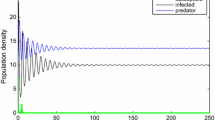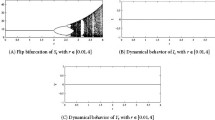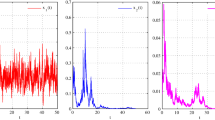Abstract
A prey–predator model with disease in prey population is considered here. The prey population is classified into two categories: susceptible prey and infected prey. The nonlinear incidence rate, at which the susceptible prey becomes infected, is incorporated. Here, predator consumes infected prey only according to Crowely–Martin functional response. Time lag is introduced to convert the susceptible prey to infected one, and the present model becomes delayed eco-epidemic model. The positivity, boundedness and permanence of the solutions of both models are guaranteed here. The existence of equilibrium points is assured. Local as well as global stability analyses of both the models around the equilibrium points are performed and finally summarized in a table, comparing the conditions between two models. The occurrence of bifurcation (saddle-node, transcritical, Hopf and Bogdanov–Takens) in the non-delay model is explored here. The nature and direction of Hopf bifurcation are searched using normal form and centre manifold theorems for delay model. Lastly, the numerical simulation is carried out to verify the analytical findings. An effort is made to search the parameters, by paying special attention to newly introduced parameters, which control the dynamics of both models. Accordingly, stable/unstable zones on \(x\tau _\mathrm{c}\)-planes, where x is any considered parameter and \(\tau _\mathrm{c}\) is the value of critical delay time, are proposed. The stranger attractor is searched in the delay model. Bifurcated diagrams of population with respect to newly introduced parameters are exemplified and discussed. When the population (S, I and P) starts oscillating, their time-averaged values are presented to show their variation due to aforesaid parameters. Moreover, pattern of all the curves \(S=S(x)\), \(I=I(x)\) and \(P=P(x)\), where x is any aforesaid parameters, are certified using their respective gradient.

















Similar content being viewed by others
References
Agiza, H.N., ELabbasy, E.M., EL-Metwally, H., Elsadany, A.A.: Chaotic dynamics of a discrete prey–predator model with Holling type II. Nonlinear Anal. Real World Appl. 10, 116–129 (2009)
Biswas, S., Sasmal, S.K., Samanta, S., Saifuddin, Md, Pal, N., Chattopadhyay, J.: Optimal harvesting and complex dynamics in a delayed eco-epidemiological model with weak Allee effects. Nonlinear Dyn. 87, 1553–1573 (2017)
Celik, C., Merdan, H.: Hopf bifurcation analysis of a system of coupled delayed-differential equations. Appl. Math. Comput. 219, 6605–6617 (2013)
Chakraborty, S., Pal, S., Bairagi, N.: Dynamics of a ratio-dependent eco-epidemiological system with prey harvesting. Nonlinear Anal. RWA. 11, 1862–1877 (2010)
Chakraborty, K., Das, K., Haldar, S., Kar, T.K.: A mathematical study of an eco-epidemiological system on disease persistence and extinction perspective. Appl. Math. Comput. 254, 99–112 (2015)
Chattopadhyay, J., Bairagi, N.: Pelicans at risk in Salton sea an eco-epidemiological study. Ecol. Model. 135, 103–112 (2001)
Gumel, A.B., Moghadas, S.M.: A qualitative study of a vaccination model with non-linear incidence. Appl. Math. Comput. 143, 409–419 (2003)
Haldar, S., Chakraborty, K., Das, K., Kar, T.K.: Bifurcation and control of an eco-epidemiological system with environmental fluctuations: a stochastic approach. Nonlinear Dyn. 80, 1187–1207 (2015)
Hassard, B.D., Kazarinoff, N.D., Wan, Y.-H.: Theory and Applications of Hopf Bifurcation. Cambridge University Press, Cambridge (1981)
Hu, G.P., Li, X.L.: Stability and Hopf bifurcation for a delayed predator-prey model with disease in the prey. Chaos, Solitons & Fractrals. 45, 229–237 (2012)
Hu, Z., Teng, Z., Zhang, T., Zhou, Q., Chen, Xi: Globally asymptotically stable analysis in a discrete time eco-epidemiological system. Chaos, Solitons Fractals 99, 20–31 (2017)
Jana, S., Kar, T.K.: A mathematical study of a prey-predator model in relevance to pest control. Nonlinear Dyn. 74, 667–683 (2013)
Jana, S., Kar, T.K.: Modeling and analysis of a prey-predator system with disease in the prey. Chaos, Solitons Fractrals 47, 42–53 (2013)
Jana, S., Guria, S., Das, U., Kar, T.K., Ghorai, A.: Effect of harvesting and infection on predator in a prey-predator system. Nonlinear Dyn. 81, 917–930 (2015)
Kar, T.K., Ghorai, A., Jana, S.: Dynamics of pest and its predator model with disease in the pest and optimal use of pesticide. J. Theor. Biol. 310, 187–198 (2012)
Li, G., Wang, W.: Bifurcation behaviour of an epidemic model with a nonlinear incidence. Appl. Math. Comput. 214, 411–423 (2009)
Liu, X.: Bifurcation of an eco-epidemiological model with a non-linear incidence rate. Appl. Math. Comput. 218, 2300–2309 (2011)
Liu, W-m, Levin, S.A., Iwasa, Y.: Influence of nonlinear incidence rates upon the behaviour of SIRS epidemiological models. J. Math. Biol. 23(2), 187–204 (1986)
Liu, W-m, Hethcote, H.W., Levin, S.A.: Dynamical behaviour of epidemiological models with non-linear incidence rates. J. Math. Biol. 25, 359–380 (1987)
Perko, L.: Differential Equations and Dynamical Systems, 3rd edn. Springer, New York (2004)
Prasad, K.D., Prasad, B.S.R.V.: Qualitative analysis of additional food provided predator-prey system with anti-predator behaviour in prey. Nonlinear Dyn. 96, 1765–1793 (2019)
Roy, P., Upadhyay, R.K.: Assessment of rabbit hemorrhagic disease in controlling the population of red fox: a measure to preserve endangered species in Australia. Ecol. Complex. 26, 6–20 (2016)
Ruan, S., Wang, W.: Dynamical behaviour of an epidemic model with a non-linear incidence rate. J. Differ. Equ. 188, 135–163 (2003)
Sahoo, B.: Role of additional food in eco-epidemiological system with disease in the prey. Appl. Math. Comput. 259, 61–79 (2015)
Tripathi, J.P., Tyagi, S., Abbas, S.: Global analysis of a delayed density dependent predator-prey model with Crowley–Martin functional response. Common Nonlinear Sci. Numer. Simul. 30, 45–69 (2016)
Upadhyay, R.K., Roy, P.: Spread of a disease and its effects on population dynamics in an eco-epidemiological system. Commun. Nonlinear Sci. Numer. Simul. 19, 4170–4184 (2014)
Wang, N., Zhao, M., Yu, H., Dai, C., Wang, B., Wang, P.: Bifurcation behaviour analysis in a predator-prey model. Hindawi Publ. Corp. 2016, 1–11 (2016)
Zhang, J.-F., Li, W.-T., Yan, X.-P.: Hopf bifurcation and stability of periodic solutions in a delayed eco-epidemiological system. Appl. Math. Comput. 198, 865–876 (2008)
Acknowledgements
Authors A. P. Maiti and D. K. Maiti acknowledge the support received from WOS-A, DST(INDIA) (Grant No. SR/WOS-A/PM-1059/2015), and DST-SERB (INDIA) (San No. SR/S4/MS/820/13 dated 07.05.2015), respectively.
Funding
WOS-A, DST(INDIA) (Grant No. SR/WOS-A/PM-1059/2015), and DST-SERB (INDIA) (San No. SR/S4/MS/820/13 dated 07.05.2015).
Author information
Authors and Affiliations
Corresponding author
Ethics declarations
Ethical approval
This article does not contain any studies with human participants or animals performed by any of the authors.
Additional information
Publisher's Note
Springer Nature remains neutral with regard to jurisdictional claims in published maps and institutional affiliations.
Appendices
Appendix A
Consider the following positive definite function about the equilibrium point \(E^*\)
where \(C_1\) and \(C_2\) are constants. Differentiating V w.r.t. time t along the solution of the system and while choosing \(C_1= \frac{1}{1+\alpha I^*} \) and \(C_2=\frac{m(1+aI^*)}{m_1(1+bP^*)(1+\alpha I^*)}\), then we have
where \(b_{11}=\frac{r}{k},\ b_{22}=C_1\left[ \frac{\alpha \beta S^*}{(1+\alpha I)(1+\alpha I^*)}- \frac{amP^*}{(1+aI)(1+aI^*)(1+bp^*)}\right] ,\ b_{33}= \left[ \frac{m_1bI^*}{(1+aI^*)(1+bP)(1+bP^*)}+e\right] C_2\) and \(\ b_{12}=\frac{r}{k}\). Clearly, \(\frac{dV}{\mathrm{d}t}=0\) if and only if \(S=S^*\), \(I=I^*\) and \(P=P^*\). The sufficient condition for \(\frac{dV}{\mathrm{d}t}\) to be negative definite around \(E_3(S^*,I^*,P^*)\) is that \( \ b_{22}>0\) and \( \ 4b_{11}b_{22}>b_{12}^2\). These conditions are satisfied under condition of Theorem 4.5. Therefore, \(E_3(S^*,I^*,P^*)\) is globally asymptotically stable under condition of Theorem 4.5.
Appendix B
Appendix C
The characteristic equation corresponding to \(E_2\) is
Clearly, one eigenvalue is \(\frac{m_1\hat{I}}{1+a\hat{I}}-d<0 \) if \(\hat{I}<\frac{d}{m_1-ad}\) (under this condition non-delay system was asymptotically stable) and other two eigenvalues are the root of the equation
where \(l_1=c+\frac{r\hat{s}}{k}\), \(l_2=\frac{rc}{k}\left( \hat{S}+\hat{I}\right) \), \(l_3=-\frac{c^2}{\beta \hat{S}}\) and \(l_4=\frac{c^3\hat{I}}{\beta \hat{S}^2}-\frac{c^2r}{\beta k}\).
Now we shall look for the condition under which the system is locally asymptotically stable and undergoes a Hopf bifurcation near \(E_2\). Putting \(\lambda =\mu +i\omega \) with \(\mu =0\), we have
and
With the help of Eqs. (6.2) and (6.3), we have
where \(\rho _1={\hat{\omega }}^2\), \(d_4=l_1^2-2l_2-l_3^2\) and \(d_5=l_2^2-l_4^2\). Now if \(d_4<0,d_5<0\) or \(d_4>0,d_5>0\), then this quadratic Eq. (6.4) will have at least one positive root and consequently a positive root for \(\omega \), say \({\hat{\omega }}\), and corresponding critical value of \(\tau \), say \(\tau _\mathrm{c}\), is given by
where \(\Delta _1=l_3^2{\hat{\omega }}^2+l_4^2\).
If \(E_2\) is locally asymptotically for \(\tau =0\), then by G.J. Butler’s lemma, \(E_2\) remains stable for \(\tau <\tau _\mathrm{c}\). The transversality condition for the Hopf bifurcation at \(\tau _\mathrm{c}\) is \(Re\left( \frac{d\lambda }{d\tau }\right) _{\tau =\tau _\mathrm{c}}>0\). So differentiating (6.1) with respect to \(\tau \) and putting \(\tau =\tau _\mathrm{c}\), \(\omega ={\hat{\omega }}\), \(\mu =0\), we get
provided \(P_1R_1-Q_1S_1>0\) where \(P_1=l_1-l_3\cos {{\hat{\omega }}\tau _\mathrm{c}}+l_3{{\hat{\omega }}\tau _\mathrm{c}}\sin {{\hat{\omega }}\tau _\mathrm{c}}+l_4\tau _\mathrm{c}\cos {{\hat{\omega }}\tau _\mathrm{c}} \), \(Q_1=-2{\hat{\omega }}-l_3{\hat{\omega }}\tau _\mathrm{c}\cos {{\hat{\omega }}\tau _\mathrm{c}}-l_3\sin {{\hat{\omega }}\tau _\mathrm{c}}+l_4\tau _\mathrm{c}\sin {{\hat{\omega }}\tau _\mathrm{c}}\), \(R_1=l_3{\hat{\omega }}^2\cos {{\hat{\omega }}\tau _\mathrm{c}}-l_4{\hat{\omega }}\sin {{\hat{\omega }}\tau _\mathrm{c}}\), and \(S_1=-l_3{\hat{\omega }}^2\sin {{\hat{\omega }}\tau _\mathrm{c}}-l_4{\hat{\omega }}\cos {{\hat{\omega }}\tau _\mathrm{c}}\). From (6.6), it is clear that the condition for the occurrence of Hopf bifurcation at \(\tau =\tau _\mathrm{c}\) is established.
Appendix D
Let \(\tau =\tau _\mathrm{c}+\mu \) where \(\mu =0\) is a Hopf bifurcation value of the system. Define the space of continuous real valued function as \(C=C([-1,0],R^3)\). Using the transformation \(u_1(t)=S-S^*\), \(u_2(t)=I-I^*\) and \(u_3(t)=P-P^*\), the system (4.1–4.4) is transformed to a functional differential equation in C as
where \(U=(u_1(t),u_2(t),u_3(t))^T\in R^3\), \(U_t(\Theta )=U(t+\Theta ) \ \ \text {for} \ \Theta \in [-1,0]\).
With \(\phi (t)=(\phi _1(t),\phi _2(t),\phi _3(t))^T\in C([-\tau ,0],R^3), \)\(L_\mu :C\rightarrow R^3\) and \(H:R\times C\rightarrow R^3\) are given as follows :
where
Using the Riesz representation theorem, there exists a matrix function \(\eta (\theta ,\mu )\) whose components are of bounded variation for \(\theta \in [-1,0]\) such that
Now we choose
where \(\delta \) is the Dirac delta function. For \(\phi \in C([-1,0],R^3)\), we define
Then Eq. (6.7) can be transformed into following operator differential equation
For \(\psi \in C^1([-1,0],(R^3)^*)\), the adjoint operator \(A^*\) of A is defined as
and a bilinear inner product is defined as
where \(\eta (\theta )=\eta (\theta ,0)\). We know that \(\pm i\omega _0\tau _\mathrm{c} \) are eigenvalues of A(0) and consequently that are of \(A^*\) also. Now we need to find eigenvectors of A and \(A^*\) corresponding to \(+i\omega _0\tau _\mathrm{c}\) and \(-i\omega _0\tau _\mathrm{c}\), respectively. Let us assume \(q(\theta )=(1,\alpha _1,\beta _1)^Te^{i\omega _0\tau _\mathrm{c}\theta }\) be the eigenvector of A(0) corresponding to \(i\omega _0\tau _\mathrm{c}\) where \(\alpha _1=\frac{i\omega _0-m_{11}}{m_{12}+n_{12}e^{-i\omega _0\tau _\mathrm{c}}}\) and \(\beta _1=\frac{m_{32}}{i\omega _0-m_{33}}\alpha _1\). Similarly assuming \(q^*(s)=D(1,\alpha ^*_1,\beta ^*_1)^Te^{i\omega _0\tau _\mathrm{c}s}\) as the eigenvector of \(A^*\) corresponding to \(-i\omega _0\tau _\mathrm{c}\), we have \(\alpha ^*_1=-\frac{i\omega _0+m_{11}}{m_{21}} \) and \(\beta ^*_1=-\frac{1}{m_{32}}[(m_{12}+n_{12}e^{i\omega _0\tau _\mathrm{c}})+(m_{22}+n_{22}e^{i\omega _0\tau _\mathrm{c}}+i\omega _0 )\alpha ^*_1]\). Now we have to calculate the value of D from \(<q^*(s),q(\theta )>=1\). Using Eq. (6.18),
where \({\bar{D}}=\left[ 1+\alpha _1\bar{\alpha ^*_1}+\beta _1\bar{\beta ^*_1}+\frac{\beta S^*}{(1+\alpha I^*)^2}\alpha _1\tau _\mathrm{c}(\bar{\alpha ^*_1}-1)e^{-i\omega _0\tau _\mathrm{c}}\right] ^{-1}\).
Now we will calculate co-ordinates to describe the centre manifold \(C_0\) at \(\mu =0\). For each \(U\in D(A)\), we may choose the pair (y, V) where
On the centre manifold \(C_0\), we have \(V(t,\theta )=V(y(t),{\bar{y}}(t),\theta )\) where
where y and \({\bar{y}}\) are local co-ordinates for centre manifold \(C_0\) in the direction of \(q^*\) and \(\bar{q^*}\) . Clearly, V is real if \(U_t\) is real. We consider real solutions only. For solution \(U_t\in C_0\) of Eq. (6.16), since \(\mu =0\), we have
where
From Eq. (6.19), we have
For \(U_t(\theta )=(U_{1t}(\theta ),U_{2t}(\theta ),U_{3t}(\theta ))\), it follows from Eq. (6.9) that
where
Comparing Eqs. (6.21) and (6.22), we have \( g_{20}=2{\bar{D}}\tau _\mathrm{c}r_1,\ g_{11}={\bar{D}}\tau _\mathrm{c}r_2,\ g_{02}=2{\bar{D}}\tau _\mathrm{c}r_3,\ g_{21}=2{\bar{D}}\tau _\mathrm{c}r_4\). Now we calculate \(V_{20}(\theta )\) and \(V_{11}(\theta )\) as they are present in \(g_{21}\). From Eqs. (6.16) and (6.19), we have
where
Again near the origin
Comparing Eqs. (6.26) and (6.27), we get
Case 1 :\(\theta \in [-1,0)\).
From Eqs. (6.19), (6.20), (6.25) and (6.26) for \(\theta \in [-1,0)\), we have
Comparing the coefficient of \(y^2\) and \(y{\bar{y}}\) between Eqs. (6.26) and (6.28),
From Eqs. (6.28) and (6.8) using the definition of A,
Similarly,
where \(E_1=(E_1^{(1)},E_1^{(2)},E_1^{(3)})\) and \(E_2=(E_2^{(1)},E_2^{(2)},E_2^{(3)})\) are constant vector in \(R^{3}\).
Case 2 :\(\theta =0\).
where \(M_1=(c_1,c_2,c_3)^T\) and \(M_2=(c_4,c_5,c_6)^T\) are the coefficient of \(y^2\) and \(y{\bar{y}}\), respectively, in \(H_0(y,{\bar{y}})\) where
Now using Eqs. (6.31) and (6.33),
This gives \(M_3E_1=2M_1\) where
By simple calculation, we have \(E_1^{(i)}=\frac{2\Delta _1^{(i)}}{\Delta _1}\) where \(\Delta _1=\det {(M_3)}\), and \(\Delta _1^{(i)}\) is the determinant value of \(M_3^{(i)}\) obtained by replacing \(i \ th \ (i=1,2,3)\) column vector of \(M_3\) by another column vector \((c_1,c_2,c_3)^T\). Similarly we have \(M_4E_2=2M_2\) where
This gives \(E_2^{(j)}=\frac{2\Delta _2^{(j)}}{\Delta _2}\), where \(\Delta _2=\det {(M_4)}\) and \(\Delta _2^{(j)}\) is the determinant value of \(M_4^{(j)}\) obtained by replacing \(j \ th \ (j=1,2,3)\) column vector of \(M_4\) by another column vector \((c_4,c_5,c_6)^T\). Thus we can compute \(V_{20}(\theta )\) and \(V_{11}(\theta )\) from Eqs. (6.31) and (6.32) and consequently \(g_{21} \) also. Moreover, the following values can be computed as
These quantities determine the direction of Hopf bifurcation at \(\tau =\tau _\mathrm{c}\).
Appendix E
The derivatives of S, I and P with respect to \(b, \alpha \) and \(\beta \) are obtained from following equations :
b | \(\beta \) | \(\alpha \) |
|---|---|---|
\(\frac{dS}{db}=-g_1 \frac{dI}{db}\) | \(\frac{dS}{d\beta }=-g_1\frac{dI}{d\beta }-\frac{kI}{r(1+\alpha I)}\) | \(\frac{dS}{d\alpha }=-g_1\frac{dI}{d\alpha }+\frac{\beta kI^2}{r(1+\alpha I)^2}\) |
\(\frac{dI}{db}=\frac{(d+eP)(1+aI)^2P+m_1g_2P^2}{m_1(1-g_2g_3)}\) | \(\frac{dI}{d\beta }=g_2\frac{\mathrm{d}P}{d\beta }\) | \(\frac{dI}{d\alpha }=g_2\frac{\mathrm{d}P}{d\alpha }\) |
\(\frac{\mathrm{d}P}{db}=g_3 \frac{dI}{db}+P^2 \) | \(\frac{\mathrm{d}P}{d\beta }=g_4\left\{ \frac{S}{1+\alpha I}-\frac{\beta kI}{r(1+\alpha I)^2} \right\} \) | \(\frac{\mathrm{d}P}{d\alpha }=\frac{(1+aI)(1+bP)^2}{m(1-g_2g_3)}\left\{ \frac{k\beta ^2 I^2}{r(1+\alpha I)^3}-\frac{\beta IS}{(1+\alpha I)^2}\right\} \) |
where \(g_1=1+\frac{\beta k}{r(1+\alpha I)^2} \), \( g_2=\frac{(e+bd+2beP)(1+aI)^2}{m_1}\), \(g_3=\left[ \frac{amP}{(1+aI)^2(1+bP)}-\frac{\alpha \beta S}{(1+\alpha I)^2}-\frac{\beta g_1}{1+\alpha I}\right] \frac{(1+aI)(1+bP)^2}{m}\) and \(g_4=\left[ \frac{m}{(1+aI)(1+bP)^2}+\frac{\alpha \beta g_2S}{(1+\alpha I)^2}+\frac{\beta g_1g_2}{1+\alpha I}-\frac{amg_2P}{(1+aI)^2(1+bP)} \right] ^{-1}\).
Rights and permissions
About this article
Cite this article
Maiti, A.P., Jana, C. & Maiti, D.K. A delayed eco-epidemiological model with nonlinear incidence rate and Crowley–Martin functional response for infected prey and predator. Nonlinear Dyn 98, 1137–1167 (2019). https://doi.org/10.1007/s11071-019-05253-6
Received:
Accepted:
Published:
Issue Date:
DOI: https://doi.org/10.1007/s11071-019-05253-6




